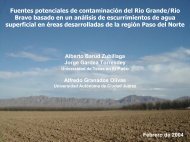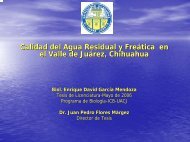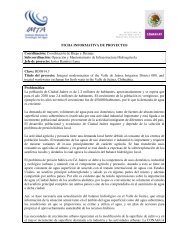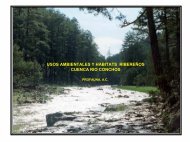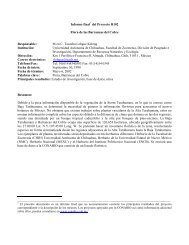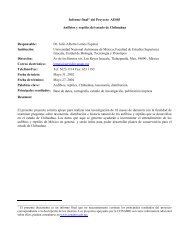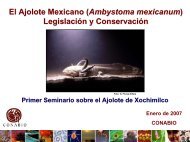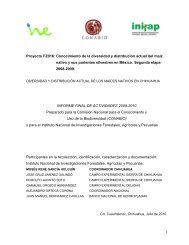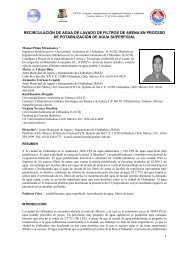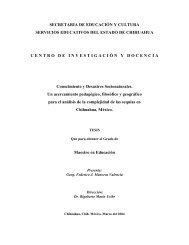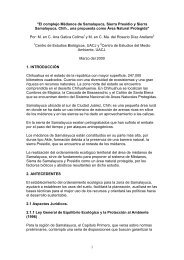14Acreage of irrigated crop<strong>l<strong>and</strong></strong> has <strong>de</strong>creased <strong>in</strong> some areas <strong>and</strong> <strong>in</strong>creased <strong>in</strong> o<strong>the</strong>rs, mak<strong>in</strong>g it hardto generalize. Acreage doubled <strong>in</strong> Santa Cruz, AZ, <strong>and</strong> Ward <strong>and</strong> Terrell, TX, while it <strong>de</strong>creaseddramatically <strong>in</strong> Presidio, Culberson, TX, <strong>and</strong> Grant <strong>and</strong> Hidalgo of southwestern New Mexico.A marked trend can be seen <strong>in</strong> <strong>the</strong> <strong>in</strong>crease of vegetable production. In all states where vegetablescan be commercially produced, farm<strong>in</strong>g has <strong>in</strong>tensified <strong>and</strong> <strong>in</strong>creased dramatically. Otero <strong>and</strong> Eddycounties, <strong>in</strong> New Mexico, <strong>in</strong>creased vegetable production 1116% <strong>and</strong> 622% respectively. In neighbor<strong>in</strong>gHidalgo (215%), Graham (291%) <strong>and</strong> Cochise (63%) counties farm<strong>in</strong>g <strong>in</strong>creased as well. This is associatedwith <strong>in</strong>creases <strong>in</strong> year-round production, mostly of chilies, onions, tomatoes, <strong>and</strong> lettuce (Figure 31)/Orchard acreage <strong>in</strong>creased as well, especially <strong>in</strong> Sierra (536%), Graham (325%), Santa Cruz(195%), Eddy (183%), Luna (111%), <strong>and</strong> Doña Ana (41%). These are fruit <strong>and</strong> pecan orchards, both highvalue crops.There is extensive <strong>use</strong> of fertilizer <strong>and</strong> pestici<strong>de</strong>s across <strong>the</strong> region, especially <strong>in</strong> those areas wherecotton or vegetables are grown (Figure 32 <strong>and</strong> 33). These agricultural chemicals can pose risks tobiodiversity.D. Case Studies of L<strong>and</strong> Use <strong>and</strong> L<strong>and</strong> Tenure around high priority conservation sites <strong>and</strong> <strong>in</strong>irrigation districts.D.1.L<strong>and</strong> Tenure <strong>and</strong> <strong>use</strong> around priority sitesIn <strong>the</strong> Chiricahua/San Pedro area most crop<strong>l<strong>and</strong></strong> is <strong>in</strong> private h<strong>and</strong>s, particularly <strong>in</strong> <strong>the</strong> two Sonoranmunicipios where over n<strong>in</strong>ety percent is held privately (91% <strong>in</strong> Agua Prieta <strong>and</strong> 94.5% <strong>in</strong> Bavispe). In <strong>the</strong><strong>Chihuahua</strong>n municipio of Janos, on 64% is <strong>in</strong> private h<strong>and</strong>s, with <strong>the</strong> bulk of <strong>the</strong> rest (35.6% ejidos. In eachof <strong>the</strong> three cases, most <strong>l<strong>and</strong></strong> is <strong>in</strong> hold<strong>in</strong>gs of more than 2500 hectares: 63.4% <strong>in</strong> Janos. 75.5% <strong>in</strong> Bavispe,<strong>and</strong> 81.5% <strong>in</strong> Agua Prieta. Less than one percent of <strong>l<strong>and</strong></strong> <strong>in</strong> each municipio is <strong>in</strong> what is traditionallyconsi<strong>de</strong>red to be “small” <strong>l<strong>and</strong></strong>hold<strong>in</strong>gs (less than five hectares). The WWF workshop i<strong>de</strong>ntified this regionas <strong>in</strong>tact”, which appears consistent with <strong>the</strong> <strong>l<strong>and</strong></strong> <strong>use</strong> date that shows little crop<strong>l<strong>and</strong></strong>. Only a small part of<strong>the</strong> Mexican portion of <strong>the</strong> Chiricahua region is <strong>in</strong> agriculture (1.27% <strong>in</strong> <strong>the</strong> municipio of Agua Prieta,Sonora; 3.95% <strong>in</strong> Bavispe, Sonora; <strong>and</strong> 5.98% <strong>in</strong> Janos, <strong>Chihuahua</strong>). Crops are planted on less than half of<strong>the</strong> arable <strong>l<strong>and</strong></strong>. The vast majority of <strong>the</strong> <strong>l<strong>and</strong></strong> <strong>in</strong> this region is <strong>in</strong> natural pasture (98.57% <strong>in</strong> Agua Prieta,96.03% <strong>in</strong> Bavispe, <strong>and</strong> 79.68% <strong>in</strong> Janos). Forest covers less than 1% <strong>in</strong> <strong>the</strong> two Sonoran municipios, while14.13% of Janos is forested. The Sierra <strong>de</strong> Los Ajos are protected un<strong>de</strong>r Mexican Forestry law <strong>and</strong> are <strong>in</strong><strong>de</strong>velopment for a Biosphere reserve. In all three municipios, less than 0.25% is classified as unproductive.The possible expansion of <strong>the</strong> m<strong>in</strong>e at Cananea could <strong>in</strong>crease water <strong>use</strong> <strong>and</strong> <strong>the</strong> risks of pollution <strong>in</strong> <strong>the</strong>area. O<strong>the</strong>r m<strong>in</strong>e <strong>de</strong>velopments are planned between Cananea <strong>and</strong> Magdalena.On <strong>the</strong> US si<strong>de</strong> a consi<strong>de</strong>rable area is offered some protection from <strong>de</strong>velopment by <strong>the</strong> US forestservice <strong>in</strong> <strong>the</strong> Chiricahuas <strong>and</strong> <strong>the</strong> San Pedro riparian Conservation Area. However, <strong>the</strong> San Pedro valley isun<strong>de</strong>r heavy <strong>de</strong>velopment pressure from <strong>the</strong> expansion of Fort Huachuca <strong>and</strong> <strong>the</strong> growth of retirementcommunities. This is plac<strong>in</strong>g particular pressure on groundwater resources that are l<strong>in</strong>ked to <strong>the</strong> flow of <strong>the</strong>San Pedro River.The WWF consi<strong>de</strong>rs this region a terrestrial <strong>and</strong> freshwater priority site <strong>and</strong> ranks <strong>the</strong> threat to <strong>the</strong>ecosystem from human activity from medium to high. The threats i<strong>de</strong>ntified by <strong>the</strong> Monterrey workshop<strong>in</strong>clu<strong>de</strong> extraction of groundwater for agriculture, water diversions for agriculture, hous<strong>in</strong>g <strong>de</strong>velopments,overgraz<strong>in</strong>g, illegal hunt<strong>in</strong>g <strong>and</strong> collect<strong>in</strong>g activities, recreation, timber harvest<strong>in</strong>g, municipal waterpollution <strong>and</strong> <strong>the</strong> impact of m<strong>in</strong><strong>in</strong>g.In three of <strong>the</strong> four municipios <strong>in</strong> <strong>the</strong> Mapimi area, private ownership predom<strong>in</strong>ates, rang<strong>in</strong>g from97.3% <strong>in</strong> Sierra Mojada <strong>and</strong> 84.4% <strong>in</strong> Jimenez to 71.4 <strong>in</strong> Mapimi. In Tlahualillo, however, ejidal hold<strong>in</strong>gsaccount for 72.1% of <strong>the</strong> worked area with<strong>in</strong> <strong>the</strong> municipio. Over half <strong>the</strong> arable <strong>l<strong>and</strong></strong> <strong>in</strong> each municipio,however, is held <strong>in</strong> titles of more than 2500 hectares. This ranges from a low of 52.7T <strong>in</strong> Mapimi, to levelsapproach<strong>in</strong>g 70% <strong>in</strong> each of <strong>the</strong> o<strong>the</strong>r three municipios (68.6T <strong>in</strong> Sierra Mojada, 70.1% <strong>in</strong> Tlahualillo, <strong>and</strong>
1571.4% <strong>in</strong> Jimenez). Small plots (less than 5 hectares) account for no more than one percent of hold<strong>in</strong>g <strong>in</strong>any municipio. Arable <strong>l<strong>and</strong></strong> is relatively low at 5.43%<strong>in</strong> Jimenez, <strong>Chihuahua</strong>: 1.30% <strong>in</strong> Sierra Mojada,Coahuila; 12.49% <strong>in</strong> Mapimi, Durango, 12.43% <strong>in</strong> Tlahualillo. Of this <strong>l<strong>and</strong></strong>, <strong>the</strong> percentage <strong>in</strong> actual crops<strong>in</strong>clu<strong>de</strong>s 51.02% of arable <strong>l<strong>and</strong></strong> <strong>in</strong> Jimenez, 13.41% <strong>in</strong> Sierra Mojada, 18.33% <strong>in</strong> Mapimi, <strong>and</strong> 51.07% <strong>in</strong>Tlahualillo.Pasture is <strong>the</strong> ma<strong>in</strong> <strong>l<strong>and</strong></strong> <strong>use</strong> <strong>in</strong> <strong>the</strong>se municipios at 94.34% <strong>in</strong> Jimenez, 97.81% <strong>in</strong> Sierra Mojada,85.80% <strong>in</strong> Mapimi, 87.09% <strong>in</strong> Tlahualillo. The threats listed <strong>in</strong> Desert Conservation Workshop report<strong>in</strong>clu<strong>de</strong> overgraz<strong>in</strong>g of goats, sheep <strong>and</strong> pigs that compete with native herbivores for forage, illegal hunt<strong>in</strong>g,over collection of birds, cacti, <strong>and</strong> reptiles, timber harvest<strong>in</strong>g, unsusta<strong>in</strong>able harvest<strong>in</strong>g of native plants, <strong>and</strong>groundwater pump<strong>in</strong>g <strong>and</strong> water diversions for agriculture <strong>in</strong> southwestern portion of <strong>the</strong> area.In <strong>the</strong> Cuatro Cienegas priority area ownership of <strong>l<strong>and</strong></strong> is mixed between ejidal <strong>and</strong> private hold<strong>in</strong>gs.In <strong>the</strong> municipios of Cuatro Cienegas <strong>and</strong> Sacramento, private ownership is by far <strong>the</strong> dom<strong>in</strong>ant form ofownership, account<strong>in</strong>g for 98.5% <strong>and</strong> 94.3% respectively. On <strong>the</strong> o<strong>the</strong>r h<strong>and</strong>, <strong>in</strong> san Pedro <strong>and</strong> Francisco I.Ma<strong>de</strong>ro, ejidal <strong>l<strong>and</strong></strong> represents <strong>the</strong> bulk of <strong>the</strong> arable area, as <strong>in</strong> San Pedro ejidos control 79.2% of arable<strong>l<strong>and</strong></strong> <strong>and</strong> <strong>in</strong> Francisco I. Ma<strong>de</strong>ro, 85.9T of all <strong>l<strong>and</strong></strong> is ejidal. L<strong>and</strong> distribution is similarly disparate, but o<strong>de</strong>snot follow <strong>the</strong> same pattern. Hold<strong>in</strong>gs of more than 250p0 hectares are more prevalent <strong>in</strong> Cuatro Cienegas(92.8%) <strong>and</strong> San Pedro (90.1%), but somewhat less dom<strong>in</strong>ant <strong>in</strong> Francisco I. Ma<strong>de</strong>ro (74.3%) <strong>and</strong>Sacramento (63%). However, as one might expect, small hold<strong>in</strong>g, although clearly relatively unimportant,are more heavily represented <strong>in</strong> <strong>the</strong> municipios where ejidos dom<strong>in</strong>ate. In Francisco I. Ma<strong>de</strong>ro 9.4% of <strong>the</strong>worked <strong>l<strong>and</strong></strong> is <strong>in</strong> plots of less than vive hectares; <strong>in</strong> San Pedro <strong>the</strong> figure is 13.1%. it is likely that <strong>the</strong>semunicipios will be affected by <strong>the</strong> agrarian reforms of <strong>the</strong> past few years, as ejiditarios take advantage of <strong>the</strong>property rights transferred to ejidos, but <strong>the</strong> large size of <strong>the</strong> hold<strong>in</strong>gs may allow <strong>the</strong> ejidos to withst<strong>and</strong> <strong>the</strong><strong>change</strong>s <strong>in</strong> <strong>the</strong> marketplace. As <strong>in</strong> <strong>the</strong> San Pedro/Chiricahuas, <strong>the</strong> vast majority of <strong>the</strong> <strong>l<strong>and</strong></strong> is <strong>in</strong> naturalpasture (96.64% <strong>in</strong> <strong>the</strong> municipio of Cuatro Cienegas, 90.01% <strong>in</strong> Francisco I. Ma<strong>de</strong>ro, 88.71% <strong>in</strong>Sacramento, <strong>and</strong> 84.15% <strong>in</strong> San Pedro). The arable <strong>l<strong>and</strong></strong> is only 3.16% of <strong>the</strong> total Cuatro Cienegas, 8.72%<strong>in</strong> Francisco I Ma<strong>de</strong>ro, 11.20% <strong>in</strong> Sacramento, <strong>and</strong> 15.49% <strong>in</strong> San Pedro. Of this 29.96% is <strong>in</strong> crops <strong>in</strong>Cuatro Cienegas, 84.07% <strong>in</strong> Francisco I Ma<strong>de</strong>ro, 41.51% <strong>in</strong> Sacramento, <strong>and</strong> 90.47% <strong>in</strong> San Pedro.Forest<strong>l<strong>and</strong></strong> is m<strong>in</strong>imal. The threats listed <strong>in</strong> <strong>the</strong> WWF Desert Conservation Workshop report <strong>in</strong>clu<strong>de</strong>groundwater pump<strong>in</strong>g for agricultural <strong>and</strong> municipal <strong>use</strong>s, water diversions from spr<strong>in</strong>gs, channelization ofstreams feed<strong>in</strong>g spr<strong>in</strong>gs <strong>and</strong> wet<strong>l<strong>and</strong></strong>s. Gypsum m<strong>in</strong><strong>in</strong>g, <strong>in</strong>vasion of exotic species, illegal hunt<strong>in</strong>g,unsusta<strong>in</strong>able harvest<strong>in</strong>g of c<strong>and</strong>elilla <strong>and</strong> cacti, <strong>and</strong> overgraz<strong>in</strong>g by goats <strong>and</strong> horses.D.3.L<strong>and</strong> <strong>tenure</strong> <strong>and</strong> <strong>use</strong> <strong>in</strong> key irrigation districtsA. 1990 report from Mexican irrigation districts provi<strong>de</strong>s some <strong>de</strong>tails on <strong>l<strong>and</strong></strong> <strong>use</strong> <strong>and</strong> <strong>tenure</strong> <strong>in</strong> <strong>the</strong>major irrigation districts of <strong>the</strong> <strong>Chihuahua</strong>n Desert (Comision Nacional <strong>de</strong> Agua 1990). The irrigationdistricts are significant to conservation beca<strong>use</strong> <strong>the</strong>y are major water <strong>use</strong>rs <strong>and</strong> often sources of pollutionfrom fertilizers <strong>and</strong> pestici<strong>de</strong>s. We exam<strong>in</strong>ed <strong>the</strong> characteristics of several important irrigation districts <strong>in</strong><strong>the</strong> <strong>Chihuahua</strong>n Desert for fur<strong>the</strong>r <strong>in</strong>formation on <strong>l<strong>and</strong></strong> <strong>tenure</strong> <strong>and</strong> <strong>use</strong>. The districts are shown <strong>in</strong> Figure 34.The Delicias Irrigation district on <strong>the</strong> Rio Conchos is 90.4% <strong>in</strong> active irrigation <strong>and</strong> about 50% ejido<strong>and</strong> private <strong>l<strong>and</strong></strong> <strong>tenure</strong>. Ejidos have about 60% of <strong>the</strong> plots between 5 <strong>and</strong> 10 hectares <strong>and</strong> 40% un<strong>de</strong>r 5hectares. Of <strong>the</strong> private <strong>l<strong>and</strong></strong> 45% is un<strong>de</strong>r 5 hectares, 25% between 5 <strong>and</strong> 10 hectares, 30% between 10 <strong>and</strong>20 hectares. The pr<strong>in</strong>cipal crops are wheat, alfalfa, cotton, peanuts <strong>and</strong> walnuts with secondary crops ofchile, maize, soy, <strong>and</strong> sorghum. In <strong>the</strong> w<strong>in</strong>ter most of <strong>the</strong> <strong>l<strong>and</strong></strong> (86%) is <strong>in</strong> oats, while <strong>in</strong> summer <strong>l<strong>and</strong></strong> <strong>use</strong> issplit between cotton (27%), peanuts (24$), chile (13%), <strong>and</strong> maize (12%). Alfalfa <strong>and</strong> walnuts areimportant perennial crops.The Valle <strong>de</strong> Juarez irrigation district along <strong>the</strong> Rio Bravo/Gr<strong>and</strong>e is about 65% <strong>in</strong> active irrigation.Of <strong>the</strong> 60% of <strong>the</strong> <strong>l<strong>and</strong></strong> <strong>in</strong> ejidos, about 60% are between 5 <strong>and</strong> 10 hectares <strong>and</strong> 30% are un<strong>de</strong>r 5 hectares.Of <strong>the</strong> private <strong>l<strong>and</strong></strong>, about 50% is held <strong>in</strong> plots un<strong>de</strong>r 5 hectares, about 25% between 5 <strong>and</strong> 10, <strong>and</strong> 15%between 10 <strong>and</strong> 20 hectares. The pr<strong>in</strong>cipal crops are wheat, cotton fruit, <strong>and</strong> alfalfa, <strong>and</strong> almost all of <strong>the</strong>



